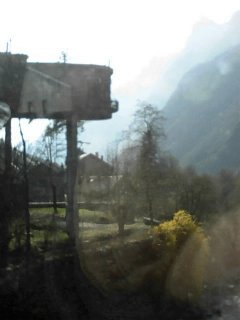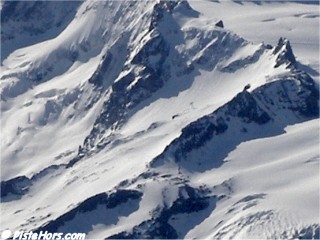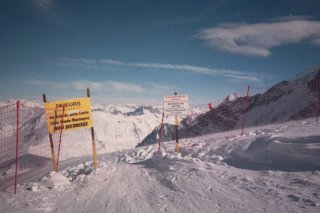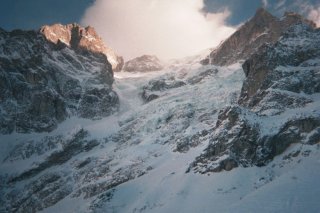
Ski-Areas > Southern Alps > Hautes-Alpes (05) > Oisans > La Grave > Off Piste
Two things should be remembered about la Grave, apart from the couple of drag lifts at the top it is an off-piste ski domain and a lot of the skiing is on glaciated terrain. Now you may have skied glaciers over the hill at les Deux Alpes or elsewhere and think, "so what?". Well those ski areas were secured by the pisteurs. Crevasses are filled and dangers are marked with signposts and fences. So long as you stick to the pistes you are pretty much safe. At la Grave, along with the avalanche risk you have the complications of a high mountain environment: variable snow conditions, crevasses, rimayes, stone, ice and sérac falls. The snow conditions can vary from day to day and season to season. A 40 degree slope with ice is very different from one with powder. The locations of crevasses can change and the glacier can move making slopes steeper or exits impossible without a rope. Unless you are very familiar with this kind of environment we recommend hiring a guide who will also be able to find the best conditions.

The Vamos Guidebook covering l'Alpe d'Huez, les Deux Alpes and la Grave can be bought from Facewest in the United Kingdom or directly from the publisher Editions Vamos.
Google-Earth:La-Grave - GPS Routes
In the late autumn of 1991 I drove up to the Col du Lauteret with my old ski buddy Steve Hinde. Leaving Grenoble we travelled through Vizille, a town of confusing road priorities and home of Thierry Claveyrolat, a grimpeur, as cyclists who can win mountain stages of big bike races are called. Thierrys abilities had earned him the nickname the Eagle of Vizille. Apart from Thierry, Vizelles only other claim to fame was as the birthplace of the French revolution in 1788. Thats right, the good citoyens were a whole year too early when they marched on the kings château. However their actions provoked the night of the tiles in nearby Grenoble where the royal soldiers were repelled by tile throwing locals who had taken to the roof tops. They were rewarded with their own parliament and some autonomy from the kings writ. The end had begun and the Bourbon dynasty would be remembered for little more than a chocolate biscuit.
Beyond Vizille the road enters a desolate post-industrial wasteland. A recent landslip had cut the old road and a couple of temporary and extremely slippery army bridges transported us across the meandering Romanche. In Livet we stopped for petrol at what seemed to be the only lit inhabitation for miles around. The Pechiney aluminium factories glowed and snorted sulphurous fumes into the cold mountain air. The pump attendant appeared to be suffering from Gautre. Pushing into the yellowing shop lit by a dim 40 watt bulb I half expected to find a six fingered banjo player.

Crimson Rivers
At Gavet the road hooks left back over the Romanche. The stilted house on left featured in the thriller Les Rivières Pourpres (The Crimson Rivers) and on the left it was possible to make out some abandoned buildings with old cars trapped on the upper levels after the access ramp collapsed. Bourg dOisans passed. This is the start of the famous 21 hairpins that lead to the top of lAlpe dHuez. The road now began to climb and narrowed to single track, seemingly suspended half way up a cliff with the bubbling river somewhere far below. A sign warned that traffic lights would flash in case of avalanche but how did they know when snow or rocks would come crashing down from the mountain above?
Finally at the Lac du Chambon the view opened up to reveal the savage beauty of the upper Romanche. The Chambon is a man made lake, the summer had been particularly dry and had taken its toll. Through the middle the old road could still be made out and a stone bridge crossed the trickle of water in the centre. Dry stone walls marked out fields long since claimed by the reservoir.
Dusty snow covered the peaks and stretched down to reach the valley floor. A giant Sikorski helicopter squatting in a field was an obvious sign of the end of the cold war and collapse of the Soviet empire. Finally we pulled into a tiny village, the road sign gave it the strange name of la Grave. Steve wanted to go and find a guide he would ski with in the winter. I traced down from les Deux Alpes to a long deep valley that ran down to the resort. It seemed to be served by a single cable car but apart from that there was no obvious trace of pistes or the paraphernalia of ski stations. "what is this place?" I asked. Steve spoke in hushed tones, la Grave, and thats the Vallons de la Meije. "Can you ski here?" "Dont think about it, at least not yet", Steve counselled.

Glacier du Vallon
The cable car had been built in 1976 in order to bring some wealth from the white gold to la Grave. Before that time, adventurous skiers from les Deux Alpes had crossed over to the Vallons and returned by taxi or helicopter. Les Deux Alpes is one of the older ski resorts having been started in the 1940s. The developments at la Grave were not welcomed by all, shortly after opening the bottom station was bombed. Then operations were stopped when it turned out that the cable car did not conform with planning regulations. Steve mentioned that the cable car mustnt drop into the valley before climbing. We continued up the road and I left la Grave behind for seven years.
In January,1998 I got a job interview to run the IT department of the experimental nuclear reactor in Grenoble. I thought it would be in idea to combine this with a ski safari and I started with a week in Val dIsère with Jackie and Ian (see Pyrénées). I then spent some time in the Belledonne resorts and doing some ski touring before striking out for a couple of days in the Oisans. My targets were the mythic station of my formative ski experience : lAlpe dHuez. Id been offered and had rejected the job in Grenoble. Having already spent the best part of two years staring at the mountains from a Grenoble office window I had no wish to repeat that kind of torture. Anyway, never to go back, the say.
It had snowed for the last three days which meant that the Pic Blanc was still closed when I arrived. Id wanted to ski every black piste in a day as Steve and I had done all those years ago. The Pic finally opened in the afternoon and I consecrated the last run to the famous Tunnel. When Id first attempted this Id found the exit wall and mogul field an awesome and frightening experience. This time I had many hundreds of thousands of meters of vertical and many years under my belt. There were around 15 people on the platform and the pisteurs who were right behind me tried to encourage them down. I jumped off the wall and skied down the fall line in what I considered a superb series of linked turns, there was still fresh powder and the dreaded moguls had not yet begun to form. Near the bottom I picked up a pair of skis belonging to a Czeck girl who had fallen almost the entire length of the slope. She was sitting dazed and confused where the piste flattened out. Above the pisteurs were putting a petrified woman onto a stretcher in order to get her down. Id covered over 10,000 near perfect vertical meters that day. Surely I had become a ski virtuoso; surely now I was ready, Steve ?
The road up to la Grave was covered in the remains of the previous days snow. I resisted putting on my chains for such a short journey and slipped my Super Cinq into the cable car station parking lot just before night fall. I checked into the nearest hotel, something of a cross between Barton Fink and the Shining. La Grave city was empty, silent, still. In the restaurant near the hotel I asked where everyone was. Asleep. Apparently January was a bit early in the season, the resort gets lively in March when the sun finally makes it out from behind the mountain during the day. The legendary Derby de la Meije is held around this time.
The next day I was at the cable car station for 8.45 sharp. Already a bunch of riders were heading onto the slopes. Compared to lAlpe dHuez I suddenly realised that I was playing with the big boys. The Ricans all seemed to be skiing with guides, armed with skis as fat as barges and were talking about various couloirs : the Freaux, the Banana and the Terrace. Their were groups of Swedes, French and Dutch, ski bums and ski chickz, Panda bear eyes giving witness to the time spent in resort. They seemed well equipped with avalanche beacons, shovels and probes. "cant be too careful, man", one guy in the bubble told me. "Anyways who you skiing with partner?" I told him I was here alone. Whoa, respect ! Now I was worried, except for the links over to les Deux Alpes, nowhere at la Grave is pisted and indeed it is not even recommended that you even think of skiing there. A small gate and various warning signs let you onto the mountain. Did they check for avalanche risk, was the area secured, I didnt think so but I was relying on the fact that hundreds of skiers had passed down the main runs since the big dump and any slides had probably happened by now.

In contrast to lAlpe dHuez the strong winds had scoured any powder off the mountain leaving hard, icy slopes that had been further cut up by the previous days skiers. "Rotten conditions," a Yank told me. Yesterday had been perfect. I thought it had been closed due to the avalanche risk. "Naw, anyway we were equipped and with a guide, you missed out buddy".
I looked at the Vallons then the Chancel. The Chancel had sun and looked to have softer snow. Suddenly, from being on the crowded bubble lift I was alone, no-one, the other skiers were off elsewhere hunting powder with their guides or guide books. I looked down the slope trying to pick up the route, a long way off a forlorn post pointed the way. I set off, initially the going was reasonably easy but the slope got steeper and the snow worse as the forest neared. To the left was the Col du Lac, this run joins the Chancel from high on the Girose glacier and is reached by taking the drag lift after the top station. The lac is just below the Evariste-Chancel refuge and although frozen and snow covered is easy to pick out. The refuge is a good lunch stop on a sunny day. After the refuge there was a long traverse with some small descents. The traverse followed narrow, icy tracks and it was hard to control speed.

Next run I decided to get off at the intermediate station and try the Pylônes run. This is a somewhat steep run that follows the cable car pylons to la Grave. It was less skied than the Chancel but still required all my efforts to get to the bottom. The run can get very icy and a slip ending in one of the pylons would be very nasty.
It was now around midday, I decided to stop for some lunch then have another run at the Chancel. In the lift a mixed group of skiers were joking around "pourquoi un chien leche sa bite ?" Asked one. "parce qu'il le peut!" came the group response. They told me I should try the Vallons as theyd found that the snow was better despite or maybe because of the lack of sun.
The Vallons de la Meije is the classic descent from the top stations and is used by The Derby competition. The quickest riders take just 5 minutes to complete the 1800 meters of descent. It is possible to cut back across to the Peyrou d'Amont cable car station. As I was advised this turned out to be the best slope of the day. The sheltered and cold northern slopes had kept a lot of powder and were the easiest skiing.
<< DMC | La Grave | Trifides couloirs >>